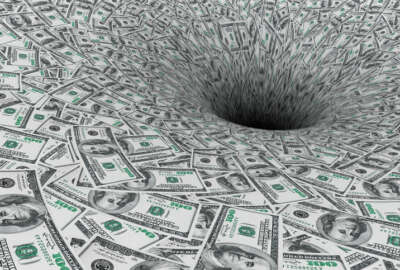Experts who predicted the record 10-year-long bull stock market would end its run last year almost got it right — almost.
Unfortunately in long-range investing for purposes of providing a lifetime nest egg for retirement, almost doesn’t cut it. Close is good, but not good enough. When the market dropped 19% last fall they came within one percentage point of seeing their forecast bear fruit. By most measures a bear market is when stocks dip 20% or more. That’s a frequent occurrence in “normal” times but it’s been 10-plus years since it last happened
There were several substantial market declines in the fourth quarter (October, November and December) of 2018 after the S&P 500 — tracked by the Thrift Savings Plan’s C fund — which was up 11% for the year until September, declined almost-but-not-quite to a bear market level Christmas Eve.
Following the drop, many investors cashed in their stock chips moving into “safer” investments to ride out the bear market. Many of them were federal and postal investors, and retirees, who moved from the C, S (small cap stocks) and I (international) funds into the “safety” of the treasury securities G fund. Many more did it during the Great Recession of 2008-2009. But as a result many did the opposite of what the pros recommend. They sold stocks when shares were declining in value and, if they eventually went back into the market, they bought high as share prices rose. The biggest losers are people who left stocks and never returned missing out in the big overall increases since 2009.
Explanations vary as to why the bull market continues. Many who predicted the market would tank if Donald Trump was elected, and again when he was actually inaugurated, or if Brexit was stalled, are still waiting to be proven correct.
Most financial planners urge clients who are investing for retirement to take the long view. To have a plan, not confuse steady low returns with safety, and to look at performance over time.
Here’s the official TSP guide to the actual performance of the C, S, I, F (bonds) and G funds as well as the Lifecycle funds from 2009 to the end of 2018. To understand how the TSP calculates rates of return for any given period of time and determines compound annual returns, read the Fact Sheet.
| Year |
G Fund |
F Fund |
C Fund |
S Fund |
I Fund |
| 2009 |
2.97% |
5.99% |
26.68% |
34.85% |
30.04% |
| 2010 |
2.81% |
6.71% |
15.06% |
29.06% |
7.94% |
| 2011 |
2.45% |
7.89% |
2.11% |
(3.38%) |
(11.81%) |
| 2012 |
1.47% |
4.29% |
16.07% |
18.57% |
18.62% |
| 2013 |
1.89% |
(1.68%) |
32.45% |
38.35% |
22.13% |
| 2014 |
2.31% |
6.73% |
13.78% |
7.80% |
(5.27%) |
| 2015 |
2.04% |
0.91% |
1.46% |
(2.92%) |
(0.51%) |
| 2016 |
1.82% |
2.91% |
12.01% |
16.35% |
2.10% |
| 2017 |
2.33% |
3.82% |
21.82% |
18.22% |
25.42% |
| 2018 |
2.91% |
0.15% |
(4.41%) |
(9.26%) |
(13.43%) |
| 10 Yr Compound |
2.30% |
3.73% |
13.17% |
13.67% |
6.48% |
Percentages in ( ) are negative.
Nearly Useless Factoid
By Amelia Brust
Until the late 19th Century, lobster was considered bargain meat or a meal for the lower classes in New England and the Canadian Atlantic coastal region, due to its abundance. But the introduction of canning, refrigeration and skillful marketing to vacationers in Maine cultivated its popularity among the wealthy. Thus, lobster prices quadrupled between 1889 and 1898 alone.
Source: Mother Jones
Copyright
© 2024 Federal News Network. All rights reserved. This website is not intended for users located within the European Economic Area.





